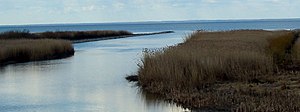Võrtsjärv
| Võrtsjärv | ||
|---|---|---|

|
||
| The Võrtsjärv and the Emajõgi River | ||
| Geographical location | Estonia | |
| Tributaries | Väike Emajõgi , Õhne , Tänassilma | |
| Drain | Emajõgi | |
| Data | ||
| Coordinates | 58 ° 17 ′ N , 26 ° 2 ′ E | |
|
|
||
| Altitude above sea level | 33.7 m | |
| surface | 270 km² | |
| length | 34.8 km | |
| width | 14.8 km | |
| scope | 96 km | |
| Maximum depth | 6 m | |
| Middle deep | 2.8 m | |

|
||
| The graphic shows the connections between the areas of the Narva | ||
The Võrtsjärv (German name Wirzsee ) is the second largest lake in the Baltic region after Lake Peipus .
It is the largest inland lake in Estonia . Võrtsjärv is located in southern Estonia in the counties of Tartumaa , Valgamaa and Viljandimaa . Its size is 270 km² (length 34.8 km, width 14.8 km). The greatest depth of the lake, the Sapi süvik , is 6 m. However, the average depth is only 2.8 m. Despite its size, Võrtsjärv is a shallow lake.
It is 33.7 m above sea level. The circumference is 96 km, the catchment area 3100 km². The lake is completely free of salt. The average air temperature at Võrtsjärv is 4.9 ° C. The lake is covered by a layer of ice for around 135 days a year. An average rainfall of 591 mm is measured annually .
The lake has 18 tributaries, the most important of which are the Väike Emajõgi , Õhne and Tänassilma rivers . The only outflow of the Võrtsjärv is the Emajõgi (German Embach ), which in turn flows into the Peipussee . On the lake, especially in its southern part, there are smaller islands, the largest of which are Ainsaar, Heinassaar, Petassaar, Pähksaar, Rättsaar, Tondisaar, Leie, Soolika ja Suurkivi vare, Pikkvare and Heinassaare vare. In the south the shore is swampy, in the north mostly sandy.
35 fish species live in the lake (according to other sources 27), mainly perch , roach , pikeperch , eel , bream and pike . The lake and its banks are a popular nesting area for migratory birds ( whooper swans , cranes , wigeons , scapula and wood sandpipers ). The lake is highly eutrophic with its high phosphorus content .
Web links
- Võrtsjärv Foundation (Estonian and English)
- Description of Võrtsjärv: Almut Weis: Võrtsjärv Lake - Estonia ( German ) Global Nature Fund (GNF) International Foundation for Environment and Nature. Retrieved March 30, 2020.
- Võrtsjärv at eestigiid.ee (Estonian)
